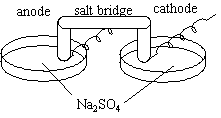17.7 Electrolysis of Water, Version II
Chemical Concept Demonstrated: Effects of electrolysis on the acidity
of a solution
Demonstration:
- Two crystallizing dishes are filled with Na2SO4; a salt bridge and
an attachment to a power supply connect them.
- Both dishes contain a universal indicator: red, acidic; blue, basic; green, neutral.
- The current is allowed to run through.
- The two dishes are combined in a beaker.
|
 |
Observations:
The water turns red at the anode and blue at the cathode. When the
dishes are mixed together, the water turns green.
Explanations (including important chemical equations):
anode: 2 H2O (l) ---> O2
(g) + 4 H+ (aq) + 4 e - E° = -1.229 V
(solution
turns from green to red)
cathode: 2 H2O (l) + 2 e - ---> H2(g) + 2 OH
- (aq) E° = -0.828 V
(solution turns from green to blue)
Electrolysis of water produces equivalent amounts of acid and
base. Notice that the cathode equation should be multiplied by two in order to
conserve the charge in the chemical reaction.
When the dishes are mixed together, the solution is neutral again.
Balancing the above equations with respect to the electrons also balances it with
respect to the water's ions, so the overall sum of the two dishes is an electrically
neutral and pH neutral solution.
